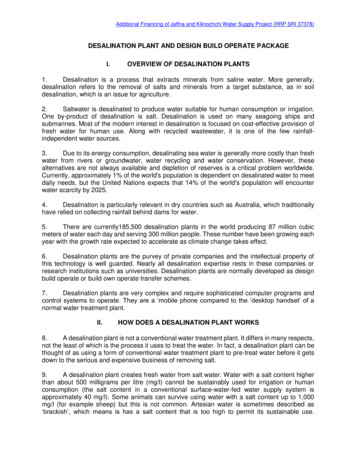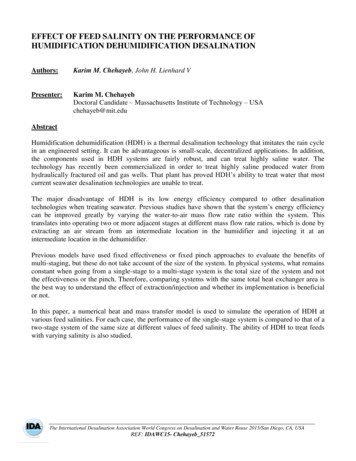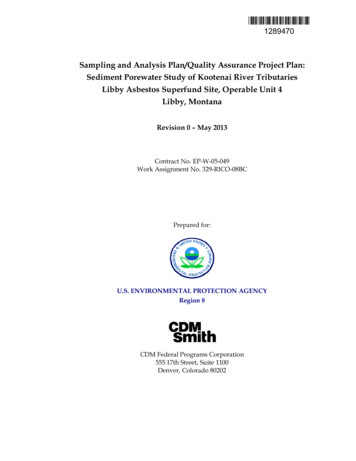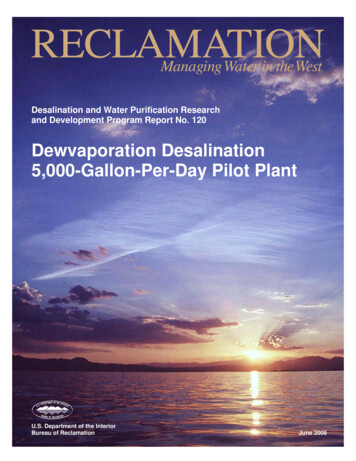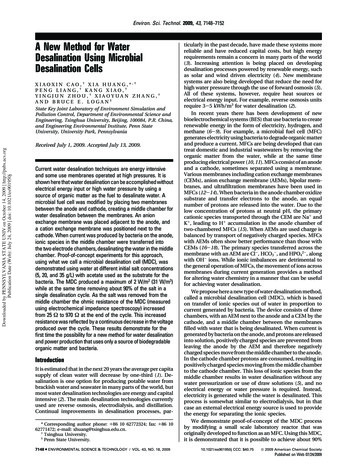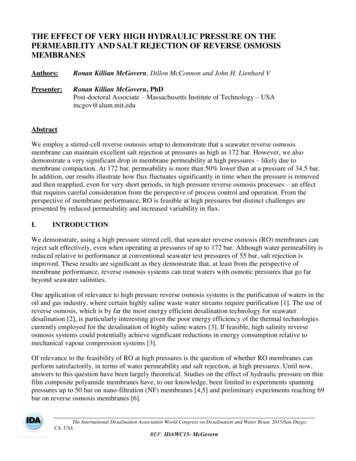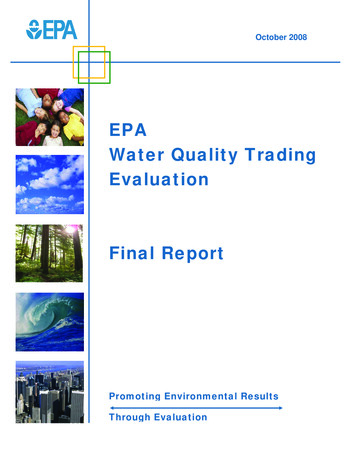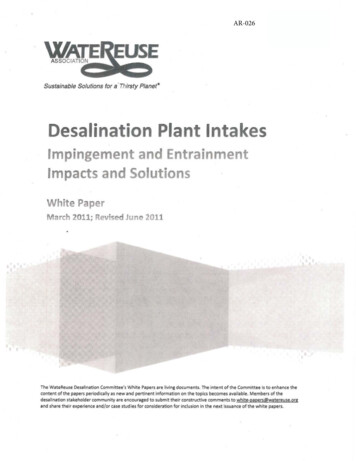
Transcription
AR-026Sustainable Solutions for a· Thirsty Planet Desalination Plant IntakesImpingement a d EntrainmentImpacts and Solutio sWhite PaperM?rch 2011; rC'visPd June 2011The WateReuse Desalination Committee's White Papers are living documents. The intent of the Committee is to enhance thecontent of the papers periodically as new and pertinent information on the topics becomes available. Members of thedesalination stakeholder community are encouraged to submit their constructive comments to white-papers@watereuse.organd share their experience and/or case studies for consideration for inclusion in the next issuance of the white papers.
WATEREUSE ASSOCIATIONDESALINATION COMMITTEEDesalination Plant Intakes Impingement and Entrainment Impacts and SolutionsWhite PaperINTRODUCTIONSeawater intakes are an integral part of every seawater desalination plant. The purpose of thiswhite paper is to provide an overview of potential impingement and entrainment (l&E) impactsassociated with the operation of open ocean intakes for seawater desalination plants and todiscuss alternative solutions for efficient and cost effective I&E reduction. For information onalternative intakes for seawater desalination plants, refer to the WateRe4se Association's whitepaper titled "Overview of Desai ination Plant Intake A lternatives.''WHAT IS IMPINGEMENT AND ENTRAINMENT?As with any other natural surface water source currently used for fresh water supply around theglobe, seawater contains aquatic organisms (algae, plankton, fish, bacteria, etc.). Impingementoccurs when organisms sufficiently large to avoid going through the screens are trapped againstthem by the force of the flowing source water- i.e., algae, plankton and bacteria are not exposedto impingement. On the other hand entrainment occurs when marine organisms enter thedesalination plant intake, are drawn into the intake system, and pass through to the treatmentfacilities.Impingement typically involves adult aquatic organisms (fish, crabs, etc.) that are large enoughto actually be retained by the intake screens, while entrainment mainly affects aquatic speciessmall enough to pass through the particular size and shape of intake screen mesh. Impingementand entrainment of aquatic organisms are not unique to open intakes of seawater desalinationplants only. Conventional open freshwater intakes from surface water sources (i.e., rivers, lakes,estuaries) may also cause measurable impingement and entrainment.A third term, "entrapment," is then used when describing impacts associated with offshore intakestructures connected to an on-shore intake screen and pump station via long conveyance pipelineor tunnel. Organisms that enter the offshore intake and cannot swim back out of it are often1referred to as entrapped Such marine organisms could either be impinged on the intake screensor entrained if they pass through the screens and enter the downstream facilities of thedesalination plant.1http://www. waterlink-intemational.com/downloadlwhitepaper uploadfile 2l.pdfSeawater Desalination Plant Intakes- Impingement and EntrainmentPage 1
Attention to seawater intake impingement and entrainment issues is partially prompted by theSection 316(b) of the 1972 Clean Water Act that regulates cooling water intake of the steamelectric industry by the environmental scrutiny associated with the public review process ofdesalination projects in California.MAGNITUDE OF ENVIRONMENTAL IMPACTSThe magnitude of environmental impacts on marine organisms caused by impingement andentrainment of seawater intakes is site specific and varies significantly from one project toanother. Open ocean intakes are typically equipped with coarse bar screens (Figure 1), whichtypically have openings between the bars of 20 mm to 150 mm followed by smaller-size ("fine")screens with openings of 1 mm to I 0 mm (Figure 2), which preclude the majority of the adultand juvenile marine organisms (fish, crabs, etc.) from entering the desalination plants. Whilecoarse screens are always stationary, fine screens could be two types - stationary (passive) andperiodically moving (i.e., rotating) screens. Figure 2 depicts a 3-mm rotating fine screen. Mostmarine organisms co.llected with the source seawater used for production of desalinated water areremoved by screening and downstream filtration before this seawater enters the reverse osmosisdesalination membranes for salt separation. After screening, the water is typically processed byfiner filters for pretreatment of seawater, which typically have sizes of the filtration mediaopenings (pores) between 0.01 microns to 0.2 microns for membrane ultra- and micro-filters and0.25 to 0.9 mm for granular media filters.Source: GHDFigure 1- Intake Bar ScreenSeawater Desalination Plant Intakes- Impingement and EntrainmentPage 2
Source: Water Globe ConsultingFigure 2 -Fine Intake ScreenBy comparison, intake wells and infiltration galleries pre-filter aquatic life through the oceanbottom sediments. In this case, the ocean bottom provides a natural separation barrier for adultand juvenile marine organisms. Since subsurface intakes collect source seawater through theocean bottom and coastal aquifer sediments (see Figure 3), they are not expected to exert animpingement type of impact on the marine species contained in the source seawater. However,the magnitude of potential entrainment of marine species into the bottom sediments caused bycontinuous subsurface intake operations is not well known and has not been systematically andscientifically studied to date. An ongoing side-by-side study of the l&E effects of a subsurfaceintake and an open ocean intake equipped with a passive wedgewire screen at the West BasinMunicipal Water District's desalination demonstration plant is expected to provide more detailedinformation on this topic2 2http://www. watereuse.org/node/978Seawater Desalination Plant Intakes- Impingement and EntrainmentPage 3
VerticalBeach WellSand/AlluvialMaterialSource: Kennedy/Jenks ConsultantsFigure 3- Subsurface Intake SchematicA comprehensive multi-year impingement and entrainment assessment study of the open oceanintakes of 19 power generation plants using seawater for once-through cooling completed by theCalifornia State Water Resources Control Board in 20 I 0 provides important insight into the3magnitude of these intake-related environmental impacts . Based on this study, the estimatedtotal average annual impingement of fish caused by the seawater intakes varied between 0.31pounds (lbs.) per million gallons a day (MGD) of collected seawater (Diablo Canyon PowerPlant) and 52.29 lbs./MGD (Harbor Generating Station); and for all 19 plants it averaged 6.63lbs./MGD. Taking into consideration that this amount is the total annual impact, the averagedaily impingement rate is estimated to be 0.018 lbs./MGD of intake flow (6.63 lbs./365 days 0.018 lbs./MGD).Using the California State Water Resources Control Board impingement and entrainment studyresults as a baseline, for a large desalination plant of 50 MGD production capacity collecting II 0MOD of intake flow , the daily impingement impact is projected to be 2 lbs. per day (0.0 18Ibs./MGD x 110 MGD 2 lbs./day). This impingement impact is less than the daily food intakeof one pelican - up to 4.0 lbs./day4 . The comparison illustrates the fact that the imp.ingementimpact of seawater desalination plants with open ocean intakes is not significant and would nothave measurable impact on natural aquatic resources (Figure u8/0uote can.htmISeawater Desalination Plant Intakes- Impingement and EntrainmentPage 4
Source: US Fish and Wildlife ServiceFigure 4- Average Daily DesaJination Intake Impingement Impact Is Less than the DailyFish Intake of One PelicanThe California State Water Resources Control Board report mentioned earlier also gives abaseline for assessment of the entrainment impact of se.awater intakes. The study indicates thatthe magnitude of such annual impact on larval fish can vary in a wide range - from 0.08 million(MM)/MGD (Contra Costa Power Plant) to 5.8 MMIMGD (Encina Power Plant) and illustratesthe fact that the entrainment impact is very site-specific.As per the same report, the average annual entrainment is estimated at 2.14 million of fish larvaeper MGD of intake flow. Prorated for a 110 MGD intake of a 50 MGD seawater desalinationplant, this annual entrainment impact is 235.4 MM of larval fish/yr. While this number seemslarge, based on expert evaluation and research, large entrainment numbers do not necessarilyequate to a measurable impact to adult fish populations because of the enormous amount of eggs,fish larvae and other zooplankton in seawater5 . Due to the large natural attrition of larval fish ,very few larval fish actually develop to juvenile and adult stages in the natural environment (seeFigure 5)6. Th majority of larvae are lost to predation, exposure to destructive forces of naturesuch as wind and wave action, and the inability to find appropriately-sized pray during the56http://www.swrcb.ca.gov/water issues/programs/ocean/cwa316/docs/workshop oakland2005/pres entations/Nov I 0 20 I0/02 Tenera nov I 0 web.pdfSeawater Desalination Plant Intakes - Impingement and EntrainmentPage 5
critical period of their development (i.e., after their yolk sack is empty). All of these forces haveseveral orders of magnitude higher impact on fish populations than seawater intakes.Source: Tenera EnvironmentalFigure 5- Typical Reproduction and Survival of Larval Producing OrganismsFor example, a single female halibut produces as many as 50 million eggs per year for as long as20 years, or one billion eggs over a lifetime7 In simple tenns, the annual entrainment impact ofone 50 MGD desalination plant would be comparable to the annual bio-productivity of fiveadult female halibut fish (i.e., the " environmental impact" which five fishermen can cause withtheir daily halibut catch quota of one fish each).The environmental impact of desalination plant operations should be assessed in the context ofthe environmental impacts of water supply alternatives that may be used instead of desalination.Desalination projects are typically driven by the limited availability of alternative lower-costwater supply resources such as groundwater or fresh surface water (rivers, lakes, etc.). However,damaging long-tenn environmental impacts may also result from continued over-depletion ofthose conventional water supplies, including inter-basin water transfers . For example, over pumping of fresh water aquifers over the years in a number of areas worldwide (i.e., the SanFrancisco Bay Delta in Northern California; wetlands in the Tampa Bay region of Florida; andfresh water aquifers, and rivers and lakes in northern Israel and Spain, which supply water tosustain agricultural and urban centers in the southern regions of these countries), has resulted insubstantial environmental impacts to the traditional fresh water resources in these regions. 8/Quote%207%20-%20Presentation.pdfSeawater Desalination Plant Intakes- Impingement and EntrainmentPage 6
such specific example of dramatic environmental impact is the reduction of the habitat of deltasmelt as a result of over-pumping caused by California State Water Project's intake faci lities.8Such long-term fresh water transfers have affected the ecological stability in the fresh waterhabitats to the extent that the long-term continuation of current water supply practices may resultin significant and irreversible damage of the ecosystems oftraditional fresh water supply sourcesand even the intrusion of saline water into the freshwater aquifers, such as the case in SalinasValley, Monterey County, California. In such instances, th e environmental impacts ofconstruction and operation of new seawater desalination projects should be weighed against theenvironmentally damaging consequences from the continued expansion of the existing fresh water supply practices.A responsible approach to water supply management must ensure that sustainable and drought proof local supplies are available, and long-term reliance on conventional water supply sources(i.e., surface water, groundwater) is reconsidered in f vor of a well-balanced and diversifiedwater supply portfolio which combines surface water, groundwater, recycled water, waterconservation, and desalination. For example, this type of reliability-driven, balanced watersupply program is currently implemented by West Basin Municipal Water District(www.westbasin.org), the Texas Water Development Board, Tampa Bay Water, and otheragencies in the United States.IMPINGEMENT AND ENTRAINMENT SOLUTIONSWhile impingement and entrainment associated with seawater intake operations are not expectedto create biologically significant ·impacts under most circumstances, best available site, design,technology, and when needed, mitigation measures, are prudent for minimizing loss of marinelife and maintaining the productivity and vitality of the aquatic environment in the v icinity of theintake.Prudent Open Intake DesignInstallation oflntake Inlet Structure Outside o(the Littoral ZoneIntakes in the littoral zone (i.e., the near-shore zone encompassed by low and high tide levels)have the greatest potential to cause elevated impingement and entrainment impacts. The US EPAconsiders extending intakes 125 meters (410 feet) o tside of the littoral zone a good engineeringpractice aimed at reduced impingement and entrainment9. According to the Office of NavalResearch, the littoral zone extends 600 feet from the shore 10 Thus, intakes with an inlet structurelocated at least 11 00 feet from the shore could result in reduced environmental impacts. Inaddition, installing the intake to depths where there is a lower concentration of living co restor delta e/cwa/3L6b/phase l/upload/2009 04 02 316b phase I support contents.QQ.[1 ralzone l.htm9Seawater Desalination Plant Intakes- Impingement.and EntrainmentPage 7
(i.e., at least 20 meters) is also expected to decrease environmental impacts associated withintake operations.Low Through-Screen VelocityImpingement occurs when the intake through-screen velocity is so high that species such as crabor fish cannot swim away and are retained against the screens. The US EPA has determined thatif the intake velocity is lower or equal to 0.5 feet per second (fps), the intake facility is deemed to11have met impingement mortality performance standards Therefore, designing intake screeningfacilities to always operate at or below this velocity would adequately address impingementimpacts.Small-Size Bar Screen OpeningsUse of bar screens with a distance between the exclusion bars of no greater than 9 inches isrecommended for preventing large organisms from entering the seawater intake 12 Suitable Fine Screen Mesh SiieAfter entering the bar screen, the seawater has to pass through fine screens to prevent debrisfrom interfering with the downstream desalination plant treatment processes. The fine screenmesh size is a very important design parameter and should be selected such that it is fitted to thesize of a majority of the larval organisms it is tar eting to protect. Typically, the openings ofmost fine screens are 3/8 inch (9.5 mm) or smaller because most adult and juvenile fish are largerthan 10 mm in head size.Design Enhancements (Or Collection o[Minimum Intake FlowMembrane reverse osmosis desalination plants typically collect seawater for one or more of thefollowing three purposes: (1) to use it as a source water for fresh water production; (2) to apply itas a backwash water for the source water pretreatment system; and (3) to pre-dilute concentrategenerated during the salt separation process down to environmentally safe salinity levels beforeit is discharged to the ocean.The percent of source seawater converted to fresh water during the desalination process is knownas plant recovery. Typically, seawater desalination plants are designed to recover 45 to 55% ofthe seawater collected by the intake. Designing the desalination plant to operate closer to theupper limits of recovery (i.e., 50 to 55%) would require collecting less water and therefore,would reduce impingement and entrainment associated with seawater intake operations. Long term testing completed by the Affordable Desalination Collaboration, aimed to identify the mostsuitable operational conditions for low-energy SWRO desalination, indicates that optimum1112http://edocket.access.gpo.gov/cfr 2008/ julgtr/pdf/40cfrl25.94.pdfhttp://www. watereuse.org/sites/defaultlfiles/u8/0uote%20 12%20-%20Policy.pdfSeawater Desalination Plant Intakes - Impingement and EntrainmentPage 8
energy consumption is achieved at a membrane flux of 9.0 gallons per square feet per day (gfd)and RO system recovery of 48% 13 Most desalination plants collect 4 to I 0% of additional water to wash their pretreatment filtrationsystems and discharge the spent filter backwash water back to the ocean. A design approachwhich may allow reducing this water use significantly is treatment and reuse of the backwashwater. Such a backwash treatment and reuse approach has cost implications but is a prudentdesign practice aimed at reducing overall plant seawater intake flow and associated impingementand entrainment.Collecting additional seawater for concentrate pre-dilution may be needed when ex1stmgwastewater intake or power plant outfalls are used for concentrate discharge and the existingoutfall volume is not sufficient to produce adequate dilution of the saline disch rge. Thisadditional flow intake could be eliminated by designing faci lities for storing concentrate duringperiods of low outfall flows when adequate dilution is not available, or by installing a dischargediffuser system which allows enhancing concentrate dissipation into the ambient marineenvironment without additional dilution.If the desalination plant production capacity has to vary diurnally, the design and installation ofvariable frequency drives on the intake pumps could also allow decreasing impingement andentrainment of the plant intake by closely matching collected source seawater volume to theplant production needs.Use of Low-Impact Intake TechnologiesImpingement and entrainment of marine organisms could be minimized by using varioussubsurface and open intake technologies. Currently, there are no federal and state regulationswhich specifically define requirements for reduction of impingement and entrainment caused bydesalination plant intakes. However, the US EPA Section 316(b) of the Clean Water Act federalregulations have stipulated national performance standards for intake impacts from powergeneration plants which require 80 to 95% reduction of impingement and 60 to 90% reduction of14entrainment as compared to those caused by uncontrolled intake conditions Technologies thatcan meet these impingement and entrainment performance standards are defined by US EPA asBest Technology Available (BTA).Subsurface IntakesSubsurface intakes (vertical and horizontal directionally drilled wells, slant wells and infiltrationgalleries) are considered a low-impact technology in terms of impingement and entrainment.However, to date there are no studies that document the actual level of entrainment reduction fhttp://edocket.access.gpo.gov/cfr 2008/julgtr/pdf/40 fr 125 .94.pdfSeawater Desalination Plant Intakes -Impingement and EntrainmentPage 9
can be achieved by these types of intakes. In addition, the potential application of a subsurfaceintake is very site specific and highly dependent on the project size; the coastal aquifer geology(aquifer soils, depth, transmissivity, water quality, capacity, etc.); the intensity of the naturalbeach erosion in the vicinity of the intake site; and on many other environmental and socio economic factors.Because optimal conditions for subsurface intakes are often ·impossible to find in the vicinity ofthe desalination plant site, the application ofthis type of intake technology to date worldwide hasbeen limited to plants of relatively small capacity. As indicated in WateReuse Association' sWhite Paper titled "Overview of Desalination Plant Intake Alternatives," 15 the largest seawaterdesalination faci lity with a subsurface intake in operation at present is the first 17 MGD phase ofthe 34 MGD San Pedro Del Pinatar (Cartagena) desalination plant in Spain. For this project, site specific hydrogeological constraints made it imposs.ible to use intake wells for plant expansion,and the second 17 MGD phase of this project was constructed with an open intake.Ongoing long-term studies of innovative subsurface intakes in Long Beach and Dana Point,California are expected to provide comprehensive data that would allow completing ascientifically-based analysis of the viability and performance benefits of subsurface intakes forlarger-size applications. The tested subsurface intake technologies are currently under evaluationand do not yet have established performance, reliability, and environmental track records.Wedgewire Screen IntakesWedgewire screens are cylindrical metal screens with trapezoidal-shaped "wedgewire" slots withopenings of 0.5 to 10 mm. They combine very low flow-through velocities, small slot size, andnaturally occurring high screen surface sweeping velocities to minimize impingement andentrainment. This is the only open intake technology approved by US EPA as Best TechnologyAvailable. Such approval, however, is granted provided that sufficient ambient conditions existto promote cleaning of the screen face; the through screen design intake velocity is 0.5 feet/secor less; and the slot size is appropriate for the size of eggs, larvae, and juveniles of any fish and16shellfish to be protected at the plant intake site Wedgewire screens are designed to be placed in a water body where significant prevailingambient cross flow current velocities ( 1 fps) exist. This high cross-flow velocity allowsorganisms that would otherwise be impinged on the wedgewire screen intake to be carried awaywith the flow.1516http://www.watereuse.org/node/ 1340http://edocket.access.gpo.gov/cfr 2006/ julgtr/pdf/40cfr 125.99.pdfSeawater Desalination Plant Intakes- Impingement and EntrainmentPage 10
An integral part of a typical wedgewire screen system is an air burst back-flush system, whichdirects a charge of compressed air to each screen unit to blow-off debris back into the waterbody, where they are carried away from the screen unit by the ambient cross-flow currents.Figure 6 presents a schematic of the wedgewire screen intake used at the 40 MGD Becktondesalination plant in London, England. The Beckton desalination plant is equipped with seven(7) 3-mm wedgewire screens installed on the suction pipe of each of the plant intake pumps.Total screen length is 11.55 ft. (3500 mm) and the screen diameter is 3.6 ft. (II 00 mm). Theplant intake is under significant influence of tidal exchange of river water and seawater. Tocapture the ebb tide and minimize entrainment, the intake adjusts as it also targets lower salinitywaters.Source: Acciona AguaFigure 6- Wedgewire Screen Intake ofBeckton Desalination PlantAn I&E study of a cylindrical wedgewire screen (Figure 7) was conducted over a 13-monthperiod from April 2009 through May 20 l 0 by Tenera Environmental for a seawater desalinationproject currently under development by the City of Santa Cruz Water Department and SoquelCreek Water District in Californra 17. The intake for the full-scale desalination project would 'bedesigned to collect of up to 7.0 MGD of source seawater in order to produce an average of 2.5MGD of fresh drinking s!Open Ocean Intake Finai%20Dec%2020 I O.pdfSeawater Desalination Plant Intakes- Impingement and EntrainmentPage 11
The tested wedgewire screen had 2.0 mm of slot openings and was constructed of copper-nickelalloy. The diameter of the screen was 8-5/8 inches; the overall screen length was 35 inches; andthe outer flange was 6-5/8 inches. Seawater was pumped from a depth of 15 to 20 feet beneaththe sea surface.Source: Tenera EnvironmentalFigure 7- Wedgewire Screen Used in Santa Cruz I&E StudyThe results of this comprehensive I&E study indicate that: No endangered, threatened, or listed species were entrained.At an average intake velocity of 0.33 fps, the screen was successful in completelyeliminating impingement.The wedgewire prevented entrainment of adult and juvenile fish species.The greatest projected proportional mortality that could be attributed to the screenoperation for the top 80% of the fish l rvae in the source water area at 7.0 MGD intakeflow was 0.06%.The greatest projected proportional mortality for the caridean shrimp and cancrid crablarvae in the source water area for 7.0 MGD intake flow was·0.02%.The extremely low proportional losses of fish, shrimp and crab populations indicate thatthe full-scale wedgewire intake screen operation at 7.0 MGD will not cause significantSeawater Desalination Plant Intakes - Impingement and EntrainmentPage 12
environmental impact considering that the natural mortality rates of these species are over99.9%.The absolute numbers of larvae projected to be entrained annually due to the collection of7.0 MGD of source seawater for desalination plant operation are a very small fraction ofthe reproductive output of the source populations of marine organisms inhabiting theintake area. For example, for the white croaker - a fish frequently encountered in theintake area- the potential larval losses (fecundity losses) are 3.6 million larvae, whichare comparable to the total lifetime fecundity (reproductive yield) of a single female fish.To study the behavioral responses of different species swimming near or contacting thewedgewire screens, two underwater video cameras were installed to view the surface of thescreens during operation. One camera was oriented to provide a lengthwise view of the screen'ssurface while a second camera videotaped a top view of the screen's surface. Videos weredisplayed and recorded to a digital video recorder (DVR) when the intake pump was operated.Figures 8, 9 and 10 present still photographs from the impingement video. The video footageshows that all fish, amphipods, and shrimps that encountered the screen were able to freethemselves after contacting the screen. The video observations allow the conclusion thatoperating the wedgewire screen intake at a through-screen velocity of 0.33 fps eliminatesimpingement.Source: Tenera EnvironmentalFigure s·- Rockfish Sitting on ScreenSeawater Desalination Plant Intakes- Impingement and EntrainmentPage 13
Source: Tenera EnvironmentalFigure 9- Shrimps Swimming Near ScreenSource: Tenera EnvironmentalFigure 10- School of Juvenile Rockfish Swimming Near ScreenSeawater Desalination Plant Intakes- Impingement and EntrainmentPage 14
A wedgewire screen intake I&E study has also been completed at the Marin Municipal WaterDistrict SWRO pilot plant near San Francisco, CA 18 . The results of this study indicated that noimpingement was observed and the larval entrainment losses were found to be less than 0.2% ofthe total larval population in the intake area of .the desalination plant. The use of cylindricalwedgewire screens is also currently being tested at the West Basin Municipal Water Districtseawater desalination demonstration plant in California.Offshore Intake Velocity CapA velocity cap is a configuration of the open intake structure that is designed to change the maindirection of water withdrawal from vertical to horizontal (see Figure 11). This configuration isbeneficial for two main reasons: (1) it eliminates vertical vortices and avoids withdrawal fromthe more productive aquatic habitat which usually is located closer to the surface of the waterbody; and (2) it creates a horizontal velocity pattern which gives juvenile and adult fish anindication for danger - most fish have receptors along the length of their bodies that sensehorizontal movement because in nature such movement is associated with unusual conditions.This natural indication combined with maintaining low through-screen velocity (0.5 fps or less)provides fish in the area of the intake ample warning and opportunity to swim away from theintake.The velocity cap intake configuration has a long track record and is widely used worldwide. Thisis the original configuration of many power plant intakes in Southern California and of all newlarge seawater desalination plants in Australia, Spain, and Israel constructed over the last fiveyears. Based on a US EPA technology efficacy assessment, velocity caps could provide over50% impingement reduction and can minimize entrainment and entrapment of marine speciesbetween the inlet structure and the fine plant screens 19 1819http://www.marinwater.org/controller?action menuclick&id 446http://www.epa.gov/watersciencel316b/phase lltechnicallch5.pdfSeawater Desalination Plant Intakes- Impingement and EntrainmentPage 15
PROBLEMSOLUTIONQ.!ll INAL VERTICAL FLOW FISH. VELOCITY HORIZONTAL FLOWSCARES fl ,. . : ,; . .:: .'\. ·.: ·. . . ·: . : ·.i ·:. ·: 0 . . .:1\. · , .·. : -::·. ' . . . .: . .HIGH.,.-.· ";·.:··. ---1 :'·:- ·: : .,.' ;,-." ,Source: US EPAFigure 11- Velocity Cap for Entrainment ReductionAs indicated previously, open intakes may also exhibit an entrapment effect - fish and ot
Source: Water Globe Consulting . Figure 2 -Fine Intake Screen . By comparison, intake wells and infiltration galleries pre-filter aquatic life through the ocean bottom sediments. In this case, the ocean bottom provides a natural separation barrier for adult and juvenile marine organisms. Since subsurface intakes collect source seawater through the
